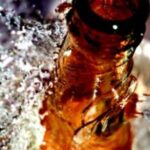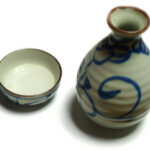Sake is a Japanese alcohol made from rice. Some people call it rice wine but it is brewed more like beer than the way wine is made. When sake is finally diluted and ready for consumption it typically contains about 15-18% alcohol. Sake has been getting popular in the world with some brewery opening in various parts of the world. Despite the new popularity less sake is being brewed in Japan.
There are two main types of sake available. Futsu-shu or ordinary sake is very basic sake. This type of sake encompasses everything from rot gut to pretty decent sake. The give an example related to whiskey to help the sake novice. This basic sake runs the gamut from Heaven Hill all the way up to Gentleman Jack. The second type is tokute meisho-sho. This is premium sake. It is basically single batch sake and not blended. It also has less “brewer’s alcohol” added into it to dilute it. This would be the equivalent of a single-malt scotch. It can be served either warm or cold. I recommend it be served warm when you are first starting to drink it. If you are drinking a premium brand you must drink it cold because the flavors and aromas can be lost because of the heat used. Sake is traditionally is served in small cups, but at some festivals it is common to drink community style from large bottles. Once opened you should keep it chilled or refrigerated to insure against spoilage and finish it within two days.
The taste and appearance of sake varies from brand to brand. Most will almost look cloudy like saliva. I do not believe I have ever seen clear sake at the stores that I have bought it from. The taste is kind of bland. It does not have the bite that a whiskey or bourbon does but you can tell you are drinking alcohol. Thinking of it as very strong beer and then some might be a way to prepare you for the taste. Here are five brands of sake that I recommend. I put a couple quality lower price bottles on here as well. This way if you do not like it you do not spend a lot of money on it.
Otokoyama is one of the highest quality sake I have consumed. I have not actually found this in my area. A friend of mine from Korea bought a bottle when he came back from visiting some relatives. If you can find it expect to pay over $100 for a 750 ml bottle. The appearance is about the most clear that you will see in sake. The taste and smell is very pleasing it almost reminds me of a melon or plum flavor. This is probably because of the fact that it is made from something called sweet rice. It has roughly 16% alcohol in it. Do not serve this warm as it is way too expensive. I also would not mix this with anything because of the price. This is brewed on the island of Hokkaido and has over 300 years of brewing tradition in Japan.
Ban Ryu is a semi-premium brand and is easier to find. It will cost about $20 for 720ml. this is more opaque but I believe it has a more pleasing taste. The smell is pleasing but you need to smell a couple times to get it. It does not come at you like some of the more expensive sake on the market. I find the taste to be very sweet and berry like. This sake is priced for you to serve it warm if you would like. You could also use this to make drinks like a sake bomb. Ban Ryu is brewed by Elko Fuji in Japan. This was actually the first sake that I bought myself. I found it to be a very good value.
Rihaku is sake that I really enjoy. It is also rather cloudy in appearance and comes in a clear bottle so you can see the color of the sake. The alcohol content is 15.5% and it has a very minor bite to it with a very slight hint of fruit flavor and aroma. Friends have told me they notice a nutty flavor but I have not noticed that. You can often get a 720ml bottle for $30-$35. Despite the lower price it is considered premium sake. This is brewed in by Rihaku Shuzo in Matsue City and has been since 1882. I think this sake is much underrated as far as the quality and taste go with the price. This is another great value. I do not care for this warm as it is really good chilled or at room temperature.
Another lower priced sake that I enjoy drinking is Tozai. This sake is brewed by Daimon Shuzo in Osaka since 1826. This is one of the more popular sake brands in Japan. The appearance is cloudy but not as extreme as some other brands in the same price range. The smell is almost like a pear yet the taste is a bit of a bit with a licorice flavor. A 720ml bottle will cost between $20-$25. I have had this both warm and chilled. It is good either way, but I tend to prefer Tozai warm. It contains 14.9% alcohol by volume and is available in most places.
The final brand I figured I would discuss is another premium brand. Takasago Ginga Shizuku is brewed by Takasago Shuzo. They have been brewing sake since 1899 and are currently located in Asahikawa City. It contains 15.6% alcohol by volume and has a rather smooth taste. The aroma and taste here are the hard to notice at first. Like many sakes’ it will have a fruity smell and taste. This sake takes longer for you to notice. It really is kind of tasteless at first but you notice the burn. One thing is think is really neat is that they actually brew this in an ice igloo. When I first heard of this it reminded me of the idea behind cold filtered beer from Coors. The liquor stores that I buy this at often have it cold and I recommend serving it cold. This is a bit harder to find but many stores will carry it. a 720ml bottle will cost you about $45-$50.
These are five of the better brands of sake that I have tried. Like anything else individual tastes do vary. What I think has a pear taste someone else might think has an apple taste to it. I usually only drink sake when I am making Asian food for a dinner at my home. If you decide to pair it with food I would highly recommend not eating raw fish at first. This can cause you to not fully appreciate the flavor of the sake. If you have eaten sushi before and like it then by all means eat it. Enjoy and remember to not drink and drive.
Sources
The Sake Handbook by John Gautner (Paperback – November 15, 2002)
Collins Park liquors
Hanks House of Liquors
The Executive Lounge
New Castle Rod and Gun Club





